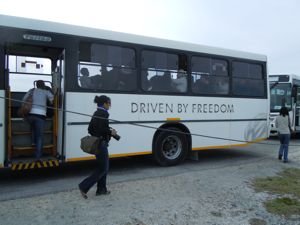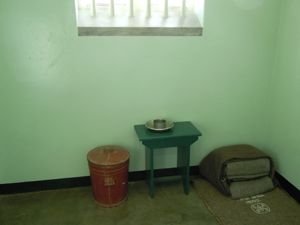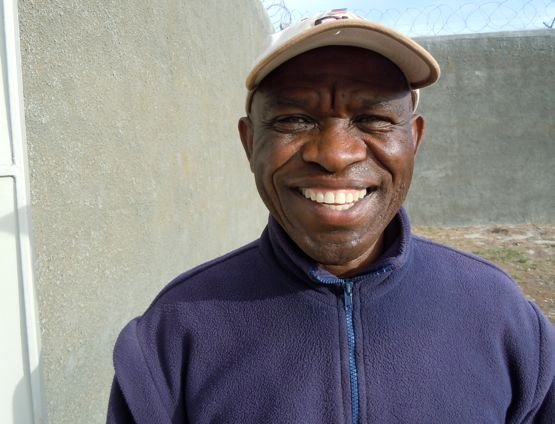Robben Island turns out to have much more to it than a single famous prison cell. We found this out yesterday afternoon, when Darlene and I took a ferry carrying about 300 visitors to the island, where we were met by three buses, each with the words “Driven by Freedom” emblazoned on the side. Our guided bus tour of the grounds included a stop at the limestone quarry where Nelson Mandela was assigned to hard labor for part of his 17 years at Robben Island. The prison is no longer in operation, except as a museum, but there is a school for 19 children, a conference center, an Anglican church, a mosque, and other buildings at the compound, tended by a staff of operations employees and guides.
 I doubt that I was the only one wondering when we would see Mandela’s cell, and if we would be able to enter it. Finally, the buses dropped us off at an entrance to the prison itself, and we were split up into groups of about 25 people, each assigned to a guide.
I doubt that I was the only one wondering when we would see Mandela’s cell, and if we would be able to enter it. Finally, the buses dropped us off at an entrance to the prison itself, and we were split up into groups of about 25 people, each assigned to a guide.
A man in a blue jacket and tan cap met us outside in the wind, and we followed him into the prison. “A very good afternoon, ladies and gentlemen,” the man said when we were inside. He told us his name, Itumeleng Makwela, which he kindly spelled out for me at the end of the tour, and he explained that we would first visit a communal cell in F Section, to sit down and talk about the prison.
“And when we finish here we will go to B Section,” he said. “B Section is our leaders’ section. They’ll keep all leaders here. They’ll not allow anybody else to go there — they find you there they’ll punish you if you’re not a leader — very, very strict. Those old men in that section were regarded as being very dangerous by the prison authorities.”
Mr. Makwela did not introduce himself as a former prisoner himself, but I soon sensed that his knowledge of Robben Island did not come from books. This became clear when he talked about the consequences of the guards’ catching someone with banned political books: solitary confinement. “It wasn’t nice to be in solitary confinement,” he said, “because you are alone in a dark cell there, you don’t talk to anyone. You are served one meal a day, and not a good one.” On leaving solitary confinement, some prisoners were very sick, and some had their eyes affected by the sudden light after prolonged periods of total darkness.
To prevent the guards from listening to political classes, the prisoners muffled the speakers in the communal cells with unseen blanket pieces. They passed messages between the sections of the prison by cutting them into tennis balls and hitting them over the walls.
Mr. Makwela provided more details of prison life when we were seated along the sides of a communal cell that would have held between 30 and 40 people, sleeping on the floor in the 1960s and 1970s, before beds were added in the 1980s.
 At the very end of the tour he took us down a corridor in B Section, where each of us had a few moments to peer into Nelson Mandela’s cell through a window and a door. The entrance was barred, but our view of the bucket used as the toilet, a simple table and two blankets gave a sobering sense of the accommodations. Our procession of visitors stopping to behold the cell reminded me of a Catholic Mass, in which the communicants walk to the front of the church, one by one, to receive the sacraments.
At the very end of the tour he took us down a corridor in B Section, where each of us had a few moments to peer into Nelson Mandela’s cell through a window and a door. The entrance was barred, but our view of the bucket used as the toilet, a simple table and two blankets gave a sobering sense of the accommodations. Our procession of visitors stopping to behold the cell reminded me of a Catholic Mass, in which the communicants walk to the front of the church, one by one, to receive the sacraments.
It’s a tribute to the man who spent 17 years in that cell, preparing to help lead his nation up from apartheid without civil war, that Mr. Makwela’s account of his incarceration seemed so free of bitterness and rage. He was arrested in 1982 on the border of Botswana and South Africa, as a result of his activity in the military wing of the African National Congress (ANC). He was tortured and subjected to a mock execution in an electric chair.
From what we’ve seen so far in this very limited exposure to the reality of South Africa, many challenges remain in the wake of the peaceful ending of apartheid in 1994. Nelson Mandela will turn 93 next year, on July 18. His presence still seems to hold the nation together.
 Send to Kindle
Send to Kindle

